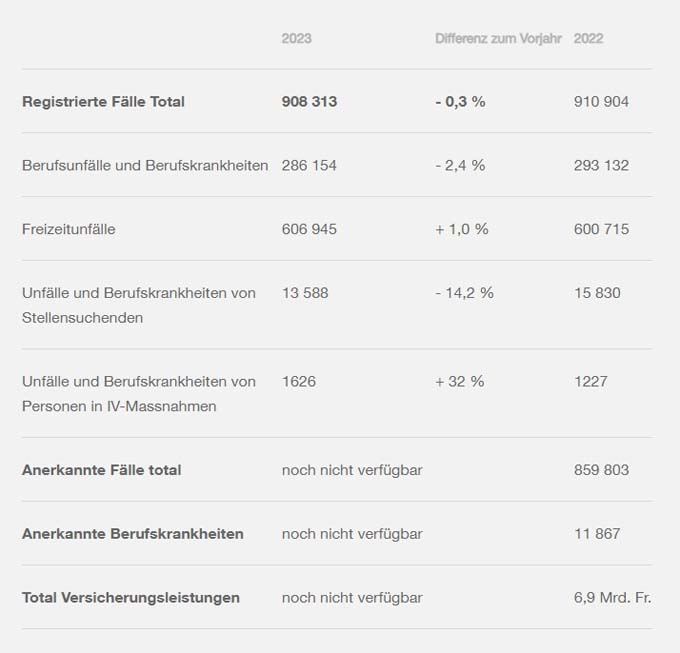Over 900,000 accidents in Switzerland: fewer occupational accidents and illnesses
In 2023, around 908,000 occupational and leisure accidents and occupational illnesses were reported to the 22 Swiss accident insurers (UVG). While occupational accidents fell slightly compared to the previous year, leisure accidents increased slightly. Overall, cases and costs remained at the previous year's level. This year's accident statistics focus on a comparison between Suva's insured persons and those of other insurers.

All employees working in Switzerland are compulsorily insured against occupational accidents and illnesses in accordance with the Accident Insurance Act (UVG). Anyone who works at least eight hours a week is also insured against leisure accidents. Jobseekers and people on IV measures are also compulsorily insured against occupational and leisure accidents.
The 22 UVG insurers in Switzerland registered around 908,000 accidents and occupational illnesses in 2023 (see table). Although this corresponds roughly to the previous year's level (- 0.3%), occupational and non-occupational accident insurance developed differently: While the number of occupational accidents and occupational illnesses fell by 2.4 percent compared to the previous year (to 286,000 claims), leisure accidents increased slightly (by 1.0 percent to 607,000 claims). The number of accidents involving jobseekers fell again (- 14.2% to around 14,000 claims), as there were once again fewer registered jobseekers than in the previous year. Around 1,600 accidents were reported among people undergoing IV measures.
All UVG insurers together spent around CHF 6.9 billion on insurance benefits in 2022, primarily for medical costs (medical and therapeutic benefits), daily allowances and provisions for disability and survivors' pensions. At 63.3%, recreational accidents accounted for the largest share of costs, while 33.5% was paid out for occupational accidents and illnesses.
Composition of the insurance portfolio influences the accident rate
This year's accident statistics are devoted to the differences between Suva and the other insurers. The focus chapter illustrates the effects of the different legal structure of the insured collectives on the occurrence of accidents and consequently on case costs and premiums.
Major differences can be seen above all in occupational accident insurance. As Suva insures almost the entire commercial and industrial sector, as required by law, its policyholder base includes many companies with a high accident risk. With around 83 annual occupational accidents per 1000 full-time employees, the accident risk is around twice as high as that of other accident insurers, which mainly insure companies in the service sector. This is also reflected in the premiums. While Suva collected premiums of CHF 1.6 billion in occupational accident insurance in 2022, which corresponds to around 0.9% of the insured payroll, the net premiums of the other accident insurers were significantly lower at CHF 0.4 billion, corresponding to 0.2% of the payroll.
With regard to leisure accidents, the differences between the Suva and other insurers' portfolios are smaller. Here, the accident risk is roughly the same, with an average of 128 (Suva) and 127 (other insurers) cases per 1000 full-time positions. However, as insured persons with mainly physical work are less able to return to work quickly, Suva's portfolio of insured persons has on average longer absences from work and correspondingly higher costs: the average costs per accident at Suva amount to CHF 5700, compared with CHF 4000 for the other insurers.
The coronavirus pandemic caused a shift in the distribution of occupational diseases. While it was originally mainly manufacturing companies that had a higher risk of occupational illnesses, which are almost entirely covered by Suva, Covid-19 led to a significant increase in recognized occupational illnesses in hospitals, care homes and laboratories, the majority of which are insured by other accident insurers.
Cases registered with all UVG insurers in compulsory accident insurance:

Accident statistics and source of supply
The Swiss Accident Insurance Statistics Unit (SSUV), which is managed by Suva, publishes the annual UVG accident statistics on behalf of the Coordination Group for Accident Insurance Statistics (KSUV). The statistics are based on the results of the 22 UVG accident insurers in Switzerland (Suva, private insurers subject to the Insurance Supervision Act (VAG), public accident insurance funds, recognized health insurance funds, substitute funds), which provide compulsory insurance for employed persons against occupational and leisure accidents and occupational illnesses. Also included are the results of compulsory accident insurance for the unemployed and for persons undergoing IV measures who are insured with Suva.
The UVG statistics do not record accidents involving children, schoolchildren, students, housewives and househusbands, self-employed persons and retired persons. Essentially, therefore, it covers employees and apprentices aged between 15 and 65 who are permanently resident in Switzerland. These people make up a good half of the resident population.
The newly published UVG 2024 accident statistics contain the statistical results for the cases in 2023 and the costs and accidents in 2022. The accident statistics are available in printed form and online in German and French.
Source: www.suva.ch
This article originally appeared on m-q.ch - https://www.m-q.ch/de/ueber-900-000-unfaelle-in-der-schweiz-weniger-berufsunfaelle-und-berufskrankheiten/









